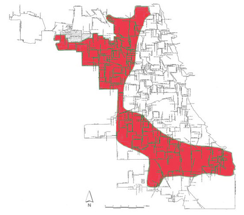The Urbanophile: Chicago: The Daley Deals by Robert Munson |
Politics + Projects = Planning……And The Deal Beyond Daley Chicago has trouble beating its rap portrayed in the popular media these days. So do the Daleys. Three books give a balanced description of what The Daley Years got done, focusing on the son’s service as Mayor from 1989 to 2011. By reviewing these books in context, this essay suggests that two key tasks in completing Chicago’s transformation — revitalized poorer neighborhoods and improved transit — requires sacrifice from taxpayers and a new deal.  Richard M. Daley was raised in a bungalow. Historians theorize his father intentionally choose this home to evoke Chicago’s Bungalow Belt, that all-encompassing crescent (in red above) stretching just outside the city’s early industrial neighborhoods; protecting contiguously from the city’s south shore through diverse western neighborhoods to the edge of the northern suburbs. Built in the teens and Roaring Twenties, the Bungalow Belt almost filled the city to its limits; as if to say how Chicago would be a city of separate neighborhoods. It serves as one of Chicago’s richer metaphors; ranging from a simple haven protecting families from the daily grind and reaching up to the Big Picture representing The American Dream. This Belt reveals how most manufacturing-based cities built their second generation residential neighborhoods; segregating filthy factories from the homes that are the primary reward for working in those factories. The story of these cities’ neighborhoods span a century: from their rapid growth ending abruptly in the Great Depression and followed by decades of decline. Some of these neighborhoods participated sketchily in the recent urban resurgence that ended in today’s lingering real estate depression. |